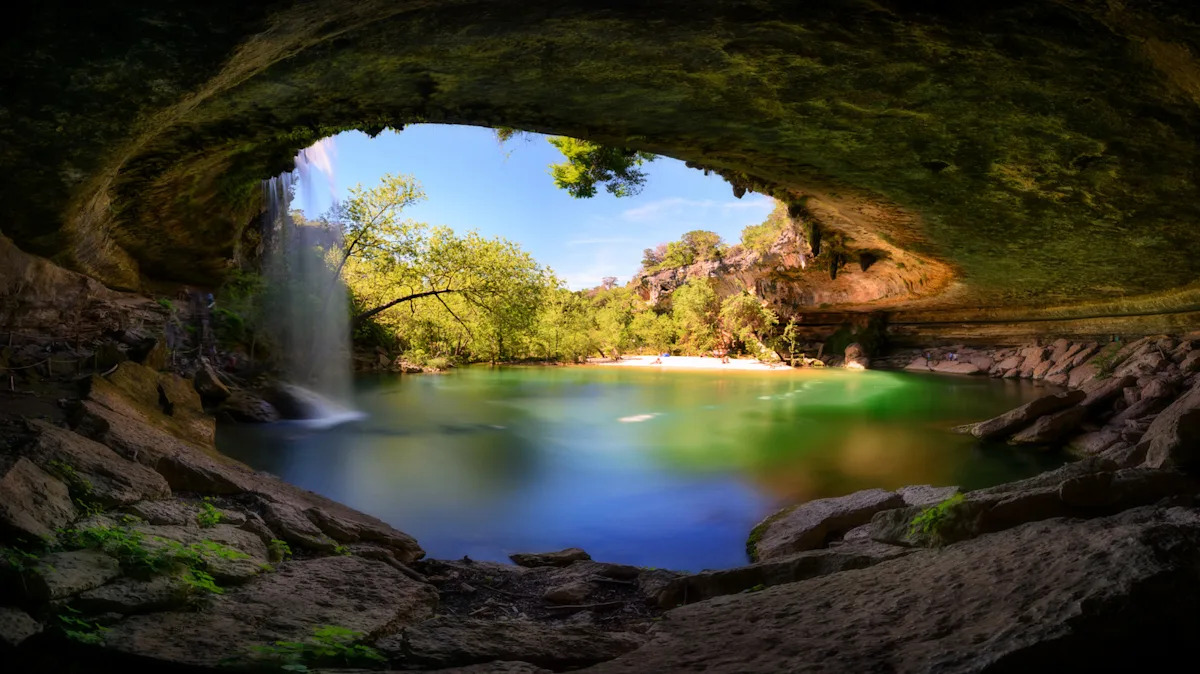Don’t go chasing waterfalls just anywhere in Texas. Austin isn’t just one of Texas’ best shopping destinations and the top-ranked BBQ city in America; residents and tourists alike can take advantage of the convenience of the big city while enjoying centuries-old nature preserves. Some of Austin’s best green oases are but a stone’s throw away from the hustle and bustle.
Casual and hardcore outdoor enthusiasts ought to include at least one nature excursion during their trip to Austin, if only to see one (or more) of the city’s breathtaking waterfalls. Despite being located less than an hour — sometimes less than 15 minutes — from the city center, these destinations promise a refresh of the mind and body through healing sights and sounds. The science behind why waterfalls can help relieve stress isn’t iron-clad, but it’s undeniable that waterfalls have proved to be a source of relaxation and inspiration for centuries, from 18th-century painters to 1990s R&B girl groups.
Most of the waterfalls in and near Austin require some hiking, but these are short journeys, making these nature spots accessible to even tourists with a fully-packed schedule.
Read more: The 5 Most Alligator-Filled Destinations In All Of Florida
McKinney Falls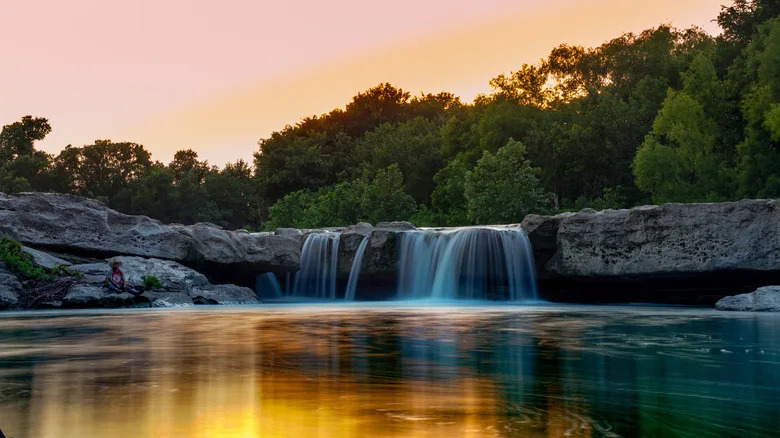
Onion Creek running through the lower McKinney Falls – Matthew Holdridge/Shutterstock
McKinney Falls State Park is one of the massive green spaces located within the Austin city limits — the state capitol is 13 miles away — talk about central! Onion Creek, a 79-mile river that flows from its source to its mouth into the Colorado River, runs through the park and provides water for the upper and lower McKinney Falls.
The upper falls, located near the McKinney Falls Smith Visitor Center, are created by Onion Creek rushing from a group of boulders, some with soft shapes and edges, and falling into a small pool. Visitors can walk above the falls onto the other side of the river, take a dip, or continue down to see the waterfalls in all their glory. The lower falls are located to the north, close to where Williamson Creek joins Onion Creek. Though less geologically impressive than the upper falls, they’re still worth checking out if you’ve got time and stamina to spare.
Park visitors are welcome to bathe and fish anywhere along Onion Creek, making it a popular spot in the spring and summer, when the temperatures are high. It’s said that people lived in or frequented the area as far back as 8,750 years ago, with various Native American artifacts discovered over the course of multiple archaeological projects. The park also features decades-old landmarks, including the remains of Thomas McKinney’s former homestead, for whom the park is named.
Sculpture Falls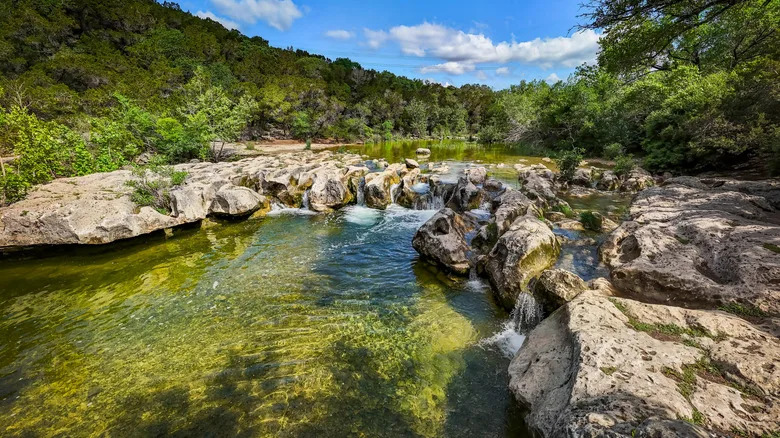
Scenic aerial view of Sculpture Falls via Barton Creek Greenbelt Trail in Austin – Photo Spirit/Shutterstock
Another major green space in central Austin is the 7.5-mile-long Barton Creek Greenbelt. Residents and tourists are welcome to retreat here for hiking, mountain biking, camping, and swimming. It’s also worth mentioning that this park allows pets, as long as they are leashed. Barton Creek, the park’s namesake, feeds two waterfalls along its main trail, Sculpture Falls and Twin Falls.
Sculpture Falls is a swimming hole known for its cool temperatures, even during the extremely hot Texas summers, with water that never goes above 70 degrees. Getting to Sculpture Falls is about a 30-minute trek from the Barton Creek Greenbelt trailhead, which leads up to the river. This route takes you by other natural sights, including Twin Falls and the Devanagari Caves, though some residents and travelers report that Twin Falls tends to dry up easily.
The Barton Creek Greenbelt is home to tons of endangered species, like the Barton Springs salamander and Austin blind salamander, which is good news for aspiring and pro photographers looking to finally get these animals in front of their lenses, but also a good reminder to leave no trace if visiting from out of town.
Link Falls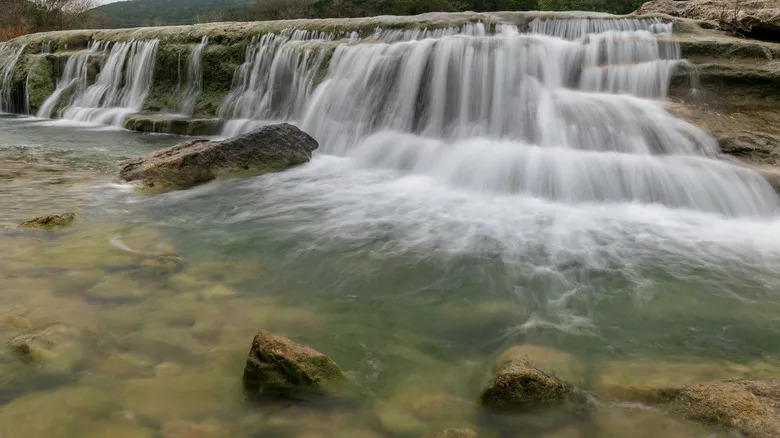
Link Falls in Bull Creek District Park, Texas – Eva Hawker/Shutterstock
Outside of the central Austin city center — though only 20 minutes by car — is Bull Creek District Park, where you can find Link Falls. These ledge falls are the biggest in the park, and adjacent to them is a swimming hole where hikers can wade. Link Falls ranks among some of the top waterfalls in Austin because it is considered one of the more reliable — water always flows well here. This makes them particularly popular, and visitors should expect the trails to be busy with fellow hikers and mountain bikers, if not crowded.
The trail to Link Falls is muddy and has many winding paths, and you’ll have to cross Bull Creek once or twice before reaching the falls. But the trail itself is lined with lush vegetation, making it a pleasurable walk among the trees out and back. Mountain bikes are allowed, but because the trail conditions vary depending on the season, making the trip on foot is recommended.
Hamilton Falls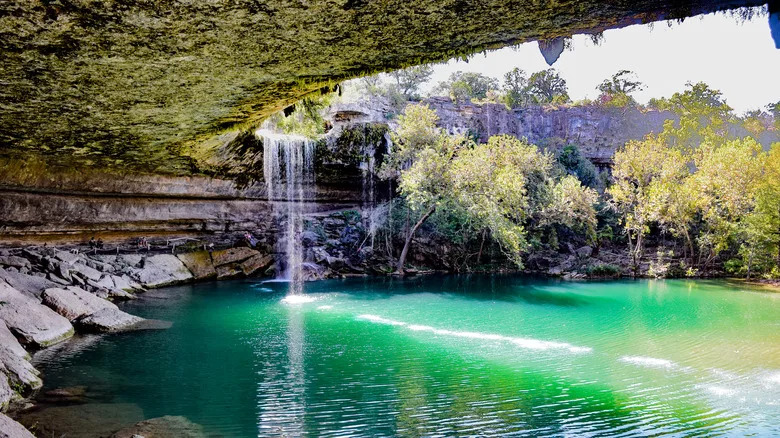
Hamilton Falls and swimming pool – mmcgowan/Shutterstock
Hiking through a rugged quarter-mile trail in the Hamilton Pool Preserve will lead to a stunning waterfall. Water comes down from Hamilton Creek, falling 50 feet down a limestone cliff, creating a spectacular view.
Tourists should note that reservations are required to visit the Hamilton Pool Reserve. At the time of writing, visitors are prohibited from walking directly under the waterfall via the trail under the overhanging cliff due to falling rocks. Bathing along the beach is allowed, though this is subject to change depending on recent weather conditions and bacteria levels in the water. On days when the water is not safe to bathe in, hikers can still walk along the trail to see the falls.
The Hamilton Pool Preserve is a swimming hole located inside the Balcones Canyonlands Preserve (BCP), one of the country’s biggest urban preserves, covering more than 33,000 acres. The BCP was created in 1996 with the main goal of protecting endangered habitats. The preserve is located a 45-minute drive from downtown Austin, and the hike to and from the falls is estimated to take around 30 minutes, making it an accessible waterfall for city dwellers and tourists who want to explore further beyond the city limits.
Pedernales Falls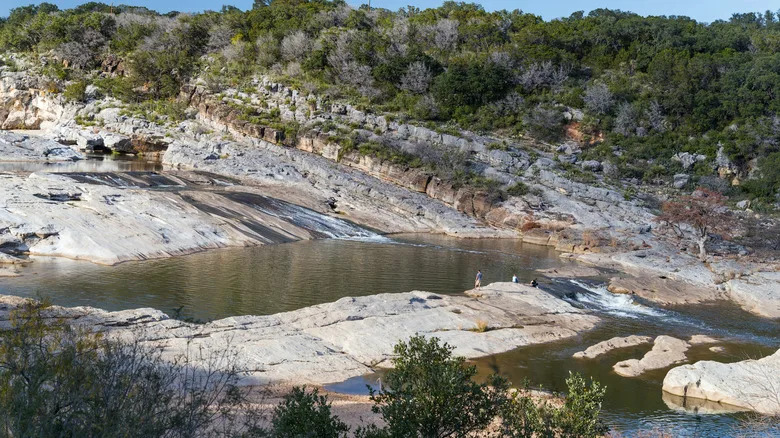
Pedernales Falls near Austin, Texas – amadeustx/Shutterstock
Further west of Austin and the Hamilton Pool Preserve is Pedernales Falls, where the Pedernales River trickles down 50 feet over a distance of 3,000 feet, creating a stunning landscape. The limestone here is said to be over 300 million years old; its soft, rounded edges are the result of centuries of erosion.
Pedernales Falls is located within its namesake state park, where visitors can not only bathe and fish in the Pedernales River but also camp and hike. To access the swimming area, visitors should expect a short hike — at least a quarter-mile — on rocky terrain.
Pedernales Falls State Park is located an hour’s drive from downtown Austin. Though technically not located in Austin, its proximity still makes it a great option for waterfall chasers. The park is not far from Stonewall, an underrated Hill Country getaway with rustic charm. It makes for an excellent day trip that combines nature, local wine, and more Texas fare — barbecue or other.
Ready to discover more hidden gems and expert travel tips? Subscribe to our free newsletter and add us as a preferred search source for access to the world’s best-kept travel secrets.
Read the original article on Islands.

